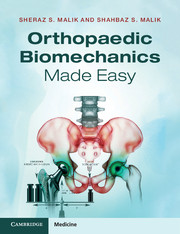Book contents
- Frontmatter
- Dedication
- Contents
- Contributors
- Epigraph
- Preface
- Acknowledgements
- Part I Orthopaedic biomaterials and their properties
- Part II Engineering theory applied to orthopaedics
- Part III Clinical biomechanics
- 6 Biomechanics of the hip and total hip replacement
- 7 Biomechanics of the knee and total knee replacement
- 8 Biomechanics of the shoulder
- 9 Biomechanics of the elbow
- 10 Biomechanics of the spine
- 11 Biomechanics of the ankle and foot
- 12 Biomechanics of fracture fixation
- 13 Trauma meeting: case-based discussions
- Index
6 - Biomechanics of the hip and total hip replacement
from Part III - Clinical biomechanics
Published online by Cambridge University Press: 05 June 2015
- Frontmatter
- Dedication
- Contents
- Contributors
- Epigraph
- Preface
- Acknowledgements
- Part I Orthopaedic biomaterials and their properties
- Part II Engineering theory applied to orthopaedics
- Part III Clinical biomechanics
- 6 Biomechanics of the hip and total hip replacement
- 7 Biomechanics of the knee and total knee replacement
- 8 Biomechanics of the shoulder
- 9 Biomechanics of the elbow
- 10 Biomechanics of the spine
- 11 Biomechanics of the ankle and foot
- 12 Biomechanics of fracture fixation
- 13 Trauma meeting: case-based discussions
- Index
Summary
Axes of the lower limbs
In the musculoskeletal system, an axis describes a plane within a structure, e.g. the axis of rotation of a joint and neutral axis in relation to bending and torsional loading of structures, or a plane of relative alignment of structures, e.g. axes of the lower limbs. It can sometimes be difficult to appreciate the three-dimensional orientation of the axes in the musculoskeletal system through descriptions and diagrams, and these are often better appreciated in a three-dimensional set-up, e.g. in computer/actual models or in a clinical/theatre setting.
The alignment of different bones and joints in the lower limbs is described by a number of axes. The comparison of these axes with each other and with different elements of the bones and joints can produce a constellation of angles and analyses. The alignment of the axes in the coronal plane is considered routinely, as lower limb deformities are more common in this plane. Therefore, the axes of the lower limb are discussed here in the coronal plane only, to simplify details and discuss important points. However, the alignment of these axes in the sagittal plane is also important and must also be considered where appropriate.
Anatomical axis
The anatomical axis describes the longitudinal anatomical alignment of the femur and tibia (i.e. the bones. This is conventionally represented by a line drawn down the center of the diaphysis of each bone. The anatomical axes of the tibia and femur intersect at the knee at the average of 6° to each other.
- Type
- Chapter
- Information
- Orthopaedic Biomechanics Made Easy , pp. 96 - 111Publisher: Cambridge University PressPrint publication year: 2015



